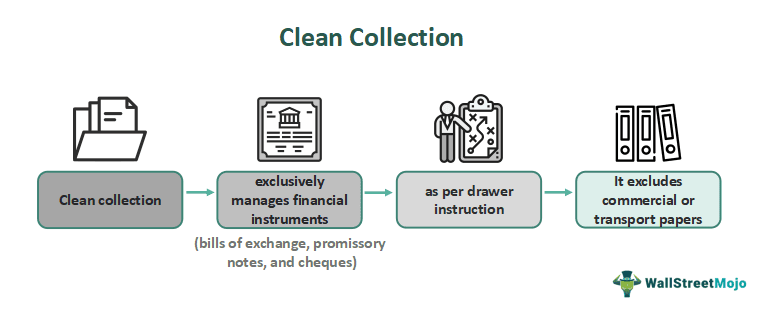Table of Contents
What Is Clean Collection?
Clean collection, as per drawer instruction, solely handles financial documents like bills of exchange, promissory notes, and cheques. It excludes commercial or transport documents. It offers speed, low costs, and enhanced payment security through the international banking network.

Moreover, it simplifies international payment collection by solely relying on financial documents (bills, notes, cheques) for low-risk transactions. This method offers speed, lower fees, and increased security through the banking network. It is considered ideal for trusted business partners.
Key Takeaways
- Clean collection is a payment method where banks handle only financial documents like bills of exchange or promissory notes.
- Clean collection is a payment method where banks handle only financial documents like bills of exchange or promissory notes.
- Advantages of clean collection include lower costs, enhanced security, and expedited processing through international banking networks.
- However, it has limited scope for complex transactions.
- Documentary collection exchanges shipping and commercial documents between banks for heightened security.
- Clean collection, however, deals solely with financial documents, prioritizing simplicity and speed but with potentially higher verification risks.
Clean Collection Explained
Clean collection in finance is a streamlined process for collecting payments in international trade without the need for accompanying commercial documents. The process begins with the consignor, or the party initiating the collection, providing a valid personal identity document to their bank. Along with this, they submit the original bill of exchange, promissory note, or check. The consignor signs the specified endorsement position on the document and fills out the clean collection application form.
Once the documents are submitted to the consignor's bank, they are forwarded to the buyer's bank through the international inter-bank network. This network ensures the secure transfer of funds and minimizes the risk associated with collecting payments directly from the payer. The global bank network facilitates convenient collection from various locations worldwide. Utilizing correspondent bank relationships can expedite the collection process. The method provides a cost-effective and efficient way to receive payments in international trade transactions.
Examples
Let's look at these examples to understand the concept better-
Example #1
Imagine Company A, based in the United States, has exported a shipment of specialized machinery to Company B, located in Japan. Company B has agreed to pay for the machinery upon receipt. To facilitate the payment, Company A opts for clean collection.
First, Company A provides their valid personal identity document, along with the original bill of exchange, to their bank in the US. They ensure to sign the specified endorsement position on the bill and fill out the clean collection application form. This includes providing necessary details such as the amount, due date, and beneficiary information.
Once the documents are submitted, Company A's bank forwards them to a correspondent bank in Japan, which then passes them on to Company B's bank. Upon receiving the documents, Company B's bank verifies the authenticity of the bill of exchange. They also ensure that the payment is in accordance with the terms agreed upon between Company A and Company B.
After verification, Company B's bank debits Company B's account for the agreed-upon amount. It sends the payment through the international inter-bank network to Company A's bank. Company A's bank then credits Company A's account with the received payment.
Example #2
Suppose Company Y in Australia imports electronic components from Company X in Japan. Company Y pays with a promissory note. To make it easy and avoid extra paperwork, Company X tells its bank to avail the benefits of clean collection for this deal. Company X's bank sends the promissory note to Company Y's bank in Australia for payment processing. The bank receives the payment from Company Y and credits Company X's account. Upon receiving the funds, Company Y's Australian bank places the amount into Company X's account balance.
Advantages And Disadvantages
The advantages and disadvantages of this method are as follows:
Advantages
- Cost-Effectiveness: This method typically incurs lower banking fees compared to other methods like documentary collections or letters of credit. This can lead to significant cost savings for both the drawer and the drawee.
- Enhanced Security: The involvement of reputable banks adds a layer of trust and reduces the risk of fraud or loss during the payment collection process.
- Accessibility: This method is suitable for various types of transactions, including small payments, foreign currency notes, and valued certificates like foreign exchange cheques, promissory notes, and deposit receipts. This versatility makes it accessible to a wide range of customers and facilitates international trade.
Disadvantages
- Limited Scope: While this method is suitable for many types of transactions, it may not be appropriate for those requiring extensive documentation or specialized handling.
- Dependency on Banking Networks: It relies on the efficiency and reliability of the international banking network. Delays or errors within this network can impact the timely processing of payments.
- Chances of Disputes: Issues such as discrepancies in documentation or disagreements over payment terms could lead to delays or complications in receiving funds.
Clean Collection Vs. Documentary Collection
The differences between clean and document collection are as follows:
| Clean Collection | Documentary Collection |
|---|---|
| This method exclusively deals with financial documents, such as bills of exchange, promissory notes, or cheques. No commercial or transport documents are involved in this process. | Banks handle commercial documents related to the shipment, such as bills of lading, invoices, and inspection certificates. These documents are forwarded by the exporter's bank to the importer's bank, and payment is made upon receipt of the documents. |
| This method relies solely on the banking system for payment without the verification of shipping or commercial documents | This method provides a higher level of security compared to clean collection. The importer's bank releases payment to the exporter once it receives and verifies the necessary shipping and commercial documents |
